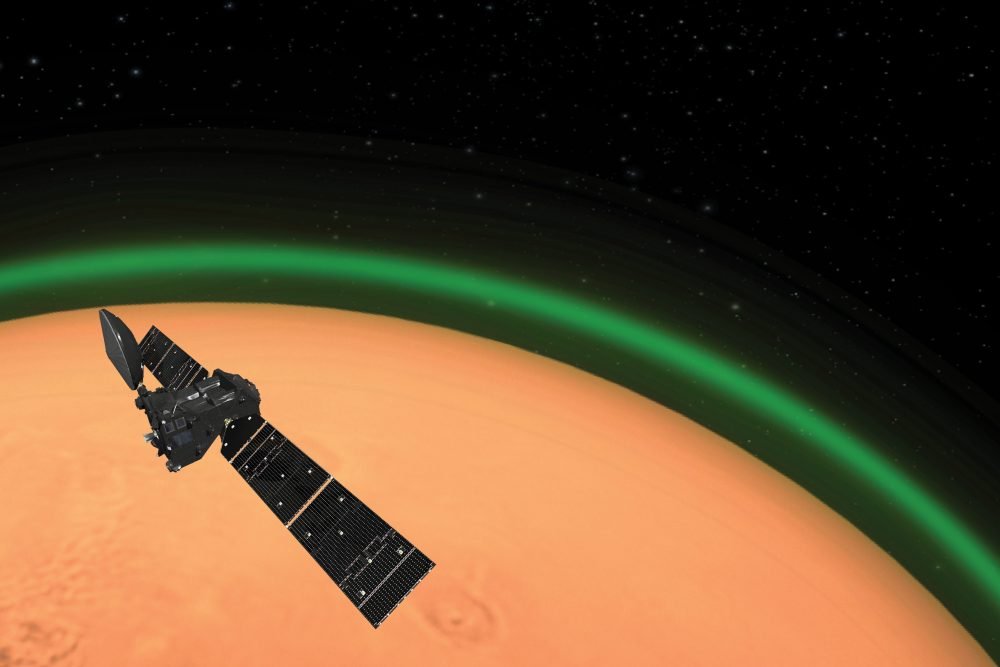Mission to Mars detects ‘green glow’ of oxygen around the Red Planet

A European spacecraft has discovered a shimmering green glow in the upper atmosphere around Mars, after a shot-in-the-dark scan that quite literally casts the Red Planet in a new light.
All evidence suggests the glow is due to the presence of oxygen (and not little green men with force fields), according to findings from the European Space Agency. The ESA detected the oxygen with its ExoMars Trace Gas Orbiter (TGO) spacecraft, according to a new study published in the Nature Astronomy journal.
The discovery doesn’t mean that humans can breathe on the surface of Mars. However, it does reveal valuable information about the Martian atmosphere that could help scientists with sending spacecraft, landers and — one day — humans to the Red Planet.
READ MORE: A football field-sized asteroid just missed Earth. No one saw it coming
The TGO spacecraft launched in 2016 and has been conducting various scans of Mars for years, but astronomers decided to rejig its instruments last year so that it could look at the Red Planet’s “edge.”
That’s when they saw the green shimmer of oxygen.
“It’s a nice result,” study co-author Manish Patel, of the U.K.’s Open University, told BBC News. “You’d never plan a mission to go looking for this kind of thing. Today, we have to be very clear about the science we’re going to do before we get to Mars; but having got there we thought, ‘Well, let’s have a look.’ And it worked.”
The green glow is caused by sunlight exciting the oxygen atoms in the Martian atmosphere, astronomers say. A similar (though not identical) phenomenon occurs with the green auroras at the Earth’s poles, although with Mars, the green glow is more of a thin band around the planet.
The Earth also has a faint, persistent oxygen-green glow around it that astronauts on the International Space Station have photographed in the past. The aura is only visible when viewed from a certain angle.
ESA
European astronomers say they were inspired to look at Mars from that same angle in hopes of seeing a similar glow.
“This emission has been predicted to exist at Mars for around 40 years,” lead study author Jean-Claude Gerard, of the Universite de Liege in Belgium, said in an ESA statement. “Thanks to TGO, we’ve found it.”
“The emission was strongest at an altitude of around 80 kilometres and varied depending on the changing distance between Mars and the Sun,” Ann Carine Vandaele, another of the co-authors on the study, said in the ESA statement.
The data shows that the atmosphere on Mars can vary in thickness — a key factor that scientists must consider when trying to punch through that atmosphere with a lander.
“By looking at the altitudes of where this emission is, you can actually tell the thickness of the atmosphere and how it’s varying,” Patel said.
READ MORE: Pentagon officially releases three leaked ‘UFO’ videos
The ExoMars team detected the green glow in all of its data across the visible and ultraviolet spectra, the ESA says.
Gerard says the glow is caused by carbon dioxide breaking down into oxygen and carbon monoxide when exposed to sunlight.
“We saw the resulting oxygen atoms glowing in both visible and ultraviolet light,” he said.
He added that the phenomenon fits with previous theoretical models, but it doesn’t quite line up with what scientists know of the faint glow around Earth.
“This suggests we have more to learn about how oxygen atoms behave, which is hugely important for our understanding of atomic and quantum physics,” he said.
The ESA hopes this new discovery will help it chart out the drag caused by sending future landers down to the Martian surface, including its upcoming Rosalind Franklin rover in 2022.



 Creators of mankind
Creators of mankind Description of “Tall white aliens”
Description of “Tall white aliens” Where they came from?
Where they came from? About hostile civilizations
About hostile civilizations The war for the Earth
The war for the Earth “Tall white aliens” about eternal life
“Tall white aliens” about eternal life Video: “Nordic aliens”
Video: “Nordic aliens” Aliens
Aliens Alien encounters
Alien encounters The aliens base
The aliens base UFO
UFO Technology UFO
Technology UFO Underground civilization
Underground civilization Ancient alien artifacts
Ancient alien artifacts Military and UFO
Military and UFO Mysteries and hypotheses
Mysteries and hypotheses Scientific facts
Scientific facts


















